Unlocking the Power of Your MG995 Servo Motor: An Essential Guide to Input Voltage
When diving into robotics, automation projects, or remote-controlled machines, the MG995 servo motor often stands out as a go-to component. Known for its strength, reliability, and affordability, this servo drives many DIY enthusiasts and professional engineers alike. But with great power comes the need for precise control — and that begins with understanding the vital role that input voltage plays in the MG995's performance.

The Basics of MG995 Servo Motor
Before delving into voltage specifics, it's helpful to understand what makes the MG995 tick. This servo motor is a hobby-grade device based on a brushed DC motor coupled with a gear train and a control circuit. It can rotate approximately 180 degrees, depending on the application and signals it receives.
The MG995 is celebrated for its high torque, typically around 13 kg·cm at 6V, making it suitable for robotic arms, steering mechanisms, and other demanding applications. It operates with pulse width modulation (PWM) signals, which tell the motor how much to turn, but the energy source powering it—your input voltage—is equally critical.
The Voltage Range: What You Should Know
The heart of the matter is the voltage supplied to the MG995. The motor's datasheet specifies a range typically between 4.8V and 7.2V, with 6V being most common in hobby applications. Operating within this range is crucial; too low, and the servo may lack the torque or responsiveness you need. too high, and you risk damaging the internal components.
Why Does Voltage Matter So Much?
Think of the input voltage as the fuel for a high-performance vehicle. Use too little, and it struggles to perform; push it beyond safe limits, and it could break down. For the MG995, supplying the correct voltage ensures:
Optimal Torque: Higher voltages within the specified range result in greater torque output, enabling the servo to handle heavier loads without stalling.
Precise Positioning: Consistent voltage levels reduce jittering and inaccuracies, leading to smoother movements and better control.
Component Longevity: Maintaining voltage within recommended limits reduces heat buildup and wear, extending the life of the servo.
Understanding the Voltage-Performance Relationship
At 4.8V, the MG995 often provides sufficient torque for simple applications, but its speed and responsiveness might be compromised. As you increase to 6V or even 7.2V (the upper limit specified by many manufacturers), you unlock higher torque and faster operation, but with specific caveats.
Voltage and Power Supply Considerations
Ensuring your power supply can deliver stable voltage within the recommended range is vital. Fluctuations, surges, or dips can all impair servo operation. Using a regulated power supply designed for hobby robotics or custom electronic projects helps maintain consistency. Proper wiring, sufficient wiring gauge, and appropriate capacitors can reduce voltage drops and noise that may interfere with control signals.
The Risks of Overvoltage
Applying voltage beyond the maximum specified—say, 8V or higher—can be tempting for extra performance but is dangerous. Excess voltage causes:
Overheating: Internal components, such as the motor coils and the gear train, will generate excess heat, leading to premature failure. Gear Damage: The increased torque and speed may break gears or cause them to slip. Circuit Damage: The control circuitry and electronics inside the servo are rated for specific voltages; exceeding these can cause permanent damage.
Practical Tips For Using MG995 at Different Voltages
Stick to 4.8V – 6V for most hobby projects, as this ensures longevity and reliable operation. For applications requiring more power, some users operate the MG995 at 7.2V, but it's imperative to verify the hardware's thermal limits and ensure proper cooling. Always use a regulated power supply with ample current capacity—at least 2A—to prevent voltage drops during high load.
Summing Up Part 1
In essence, the input voltage to your MG995 servo motor isn't just a number—it's the cornerstone of your project's success. Proper voltage ensures your servo performs smoothly, with maximum torque and minimal wear. Moving forward, the next section will explore how to select and configure power supplies, best practices for wiring, and troubleshooting tips related to input voltage issues.
Leveraging innovations in modular drive technology, Kpower integrates high-performance motors, precision reducers, and multi-protocol control systems to provide efficient and customized smart drive system solutions.




































